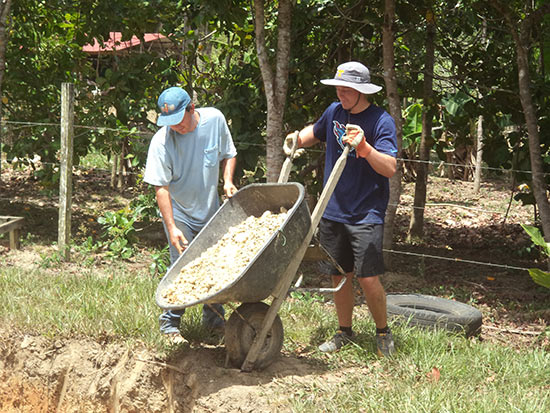Joe Willenborg: Student Report from 2015 Alternative Summer Break in Belize

There are countless things I could write about Belize, from the amusing family we stayed with to our trips downtown where we met friendly locals, as well as some of San Ignacio’s unique characters. I could also write about other volunteers we met who were there for similar projects, or delve into the details of the problems faced by orphanages in Belize (overcrowding, lack of training) and how our project aimed to fix it. However, one thing stood out to me from our work in Belize—the building process itself.
Around the time I left for Belize, my family had just begun the process of building a new house. As a result, my parents had been spending countless hours deciding on the floorplan, choosing the color of the brick and hardwood, and debating over various other issues. But what I found in Belize was quite the opposite, as our building process returned to the basics.
The leader of the project, Jaime, was formerly an architect and was probably capable of designing fascinating buildings. However, in this case he was interested in maximizing money donated to the project and ensuring the longevity and sustainability of the buildings that would eventually be occupied by girls who had left Belize’s orphanage system. Unlike, a home in the US which uses concrete, wood, steel, and other costly materials, the domes we were building utilized donated tires, dirt that had been removed from the hole we were working in (picture here), recycled grain feed bags, and barbed wire.
Rather than requiring complex machinery to cut or mix materials, our process only required a 14 foot long rod attached to a pole to lay tires in a relatively level and round circle and then manual labor to mix and fill tires and feed bags with dirt. One may think this process may seem like a waste of time since we have the technology to pour cement or use cinder blocks, but I was amazed to see just how strong the work we did was. The tires functioned as a mechanical stabilizer to form the foundation, and the lime we added to the feed bags acted as a chemical stabilizer making a circular wall that seemed to be stronger than a “state-of-the-art” building back in the states.
Jaime even went so far as to say the buildings we were working on were more likely to survive an earthquake than a well-built cinder block house. He also said that the earth-bag process we used costs around $15 a square foot compared to nearly $80 for most buildings in Belize, or in excess of $100 for homes in the US.
It is fascinating to me that we (college students who got a five-minute overview of the process) could build a structure out of no new materials using primarily dirt that is probably stronger than the house my parents are building using expert contractors, cement, and complex architectural designs. This trip showed me that simple processes and designs are often more effective than complex innovations. In addition, it illustrated just how far donations to organizations in under-privileged countries can go and how sustainable processes can also be extremely effective.